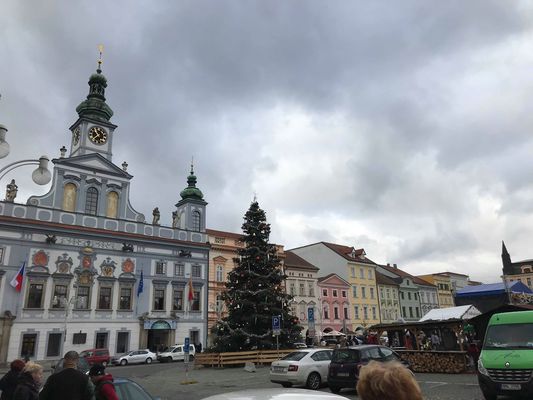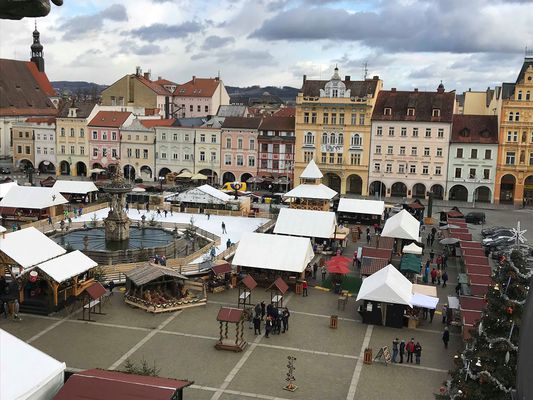CZECH REPUBLIC
ČESKÉ BUDĚJOVICE
The South Bohemian capital with a population of one ninety thousand was founded by the Bohemian King Přemysl Otakar II in 1265 on the confluence of the Rivers Malše and Vltava (Moldau) as a royal city so the king could strengthen his position of power in South Bohemia.
The strong fortifications made the city a strategically important place during the Hussite Wars, the later estates uprising and the subsequent Thirty Years’ War.
The sixteenth century brought the city unprecedented prosperity and considerable profits flowing into the city coffers particularly from the local silver mining as well as from the beer brewing, fish farming and the salt trade.
The Theresian reforms after the mid 18th century transformed České Budějovice into the seat of the newly created region.
The nineteenth century, which was characteristic for its revolutionary technical progress resulted in a fresh impetus for the development of trade and industry. The horse-drawn tramway, erected between 1825 and 1832 as the first on the European Continent, linked České Budějovice to the upper Austrian city of Linz, and together with the Vltava Waterway accelerated the transportation of goods. New enterprises were established such as a pencil factory, breweries, utensil factory and so on.
The 20th century brought further intensive development and České Budějovice became the true economic and cultural capital of South Bohemia.
After 1990 it became a statutory city with its own city mayor. Traditional commercial and cultural relations were restored with Austria, Germany and other European countries.
The economic sphere in particular experienced extensive changes. The important enterprises in the area are the Budějovický Budvar n.p. and Budějovický měšťanský pivovar a.s. breweries, Robert Bosch spol. s.r.o., Madeta Č.Budějovice a.s., Motor Jikov a.s., Koh - i – Noor Hardtmuth a.s.
The South Bohemian University with its five faculties has been active since 1991 when it was opened in České Budějovice.
The company Výstaviště Č.Budějovice a.s. (České Budějovice Exhibition Grounds) has one of the biggest exhibition grounds in the South Bohemian region. The most famous exhibitions are Země živitelka (Land The Provider), Hobby jaro a podzim (Spring and Autumn Hobbies).
A number of historical monuments have also survived to this day when the city became a political, cultural and educational centre:
Přemysl Otakar II. Square
This is one of the most beautiful squares in the Czech Republic. It is almost a perfect square in shape covering an area of 1 ha and is surrounded on all sides by Baroque burgher houses with arcades. The 18th century Baroque Samson’s Fountain, consisting of a statue of Samson fighting a lion, is situated in the centre of the square. The so-called Erratic Boulder was laid in the pavement not far from the fountain marking the site of the medieval gallows.
Historical City hall
The most prominent building on Přemysl Otakar II Square acquired its present Baroque appearance during its rebuilding in 1730. Its front is richly decorated and four larger than life statutes of virtue are positioned on its attic gable depicting Wisdom, Caution, Courage and Justice.
Black Tower
This was a major feature of the city with a height of 72 metres and until recently the highest structure in the city. In the past it was the bell and watchtower. There is a wonderful view of the whole of České Budějovice and its nearest surroundings from its gallery. The tower has 5 bells altogether, the biggest is called Bumerin (1723 – weight almost 3.5 t) and the youngest is Budvar (1995). The 17th century Baroque Cathedral of St. Nicholas stands right next to it.
Piarist Square
An impressive historical secluded spot where the oldest city building is situated, the Dominican Monastery and Church of the Sacrifice of Our Lady of 1265 – the oldest surviving city monument, which later acquired an extension in the so-called White Tower and the architecturally remarkable former armoury and salt house.
Panská street
This picturesque street contains not only many preserved burgher houses and a 15th century Gothic log cabin. The 14th centuryRabenštejn Tower, which looms above the end of this street, was part of the original city walled fortifications.
City fortifications
The remains of the city walls with further towers – the semi-circular bastion called Otakarka or the so-called Železná panna (Iron Maiden), which apparently was used as a torture chamber – have survived alongside the Rivers Malše and blind bend of the Vltava.

